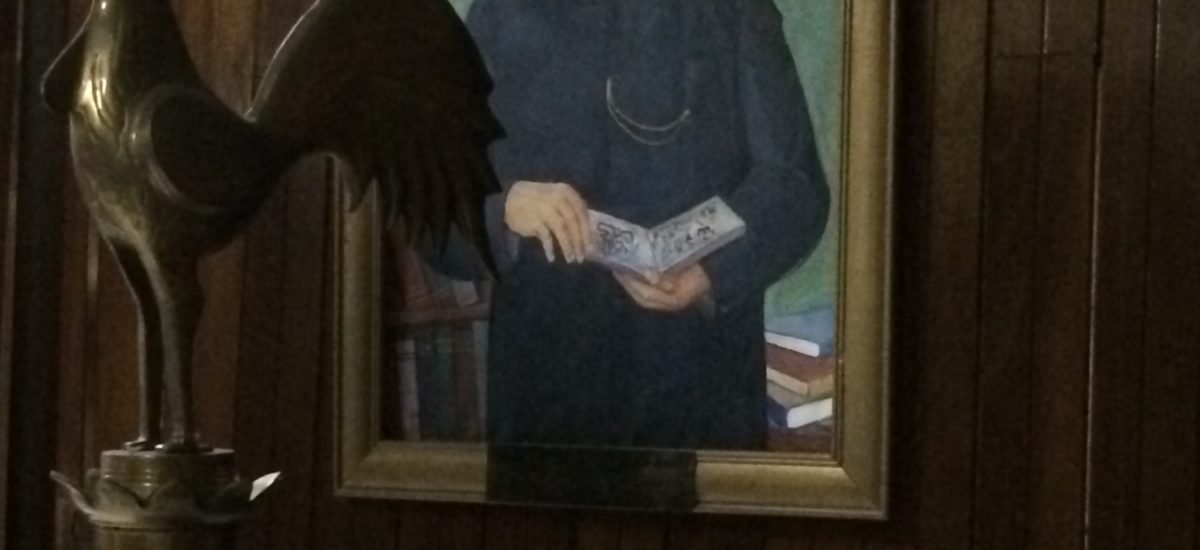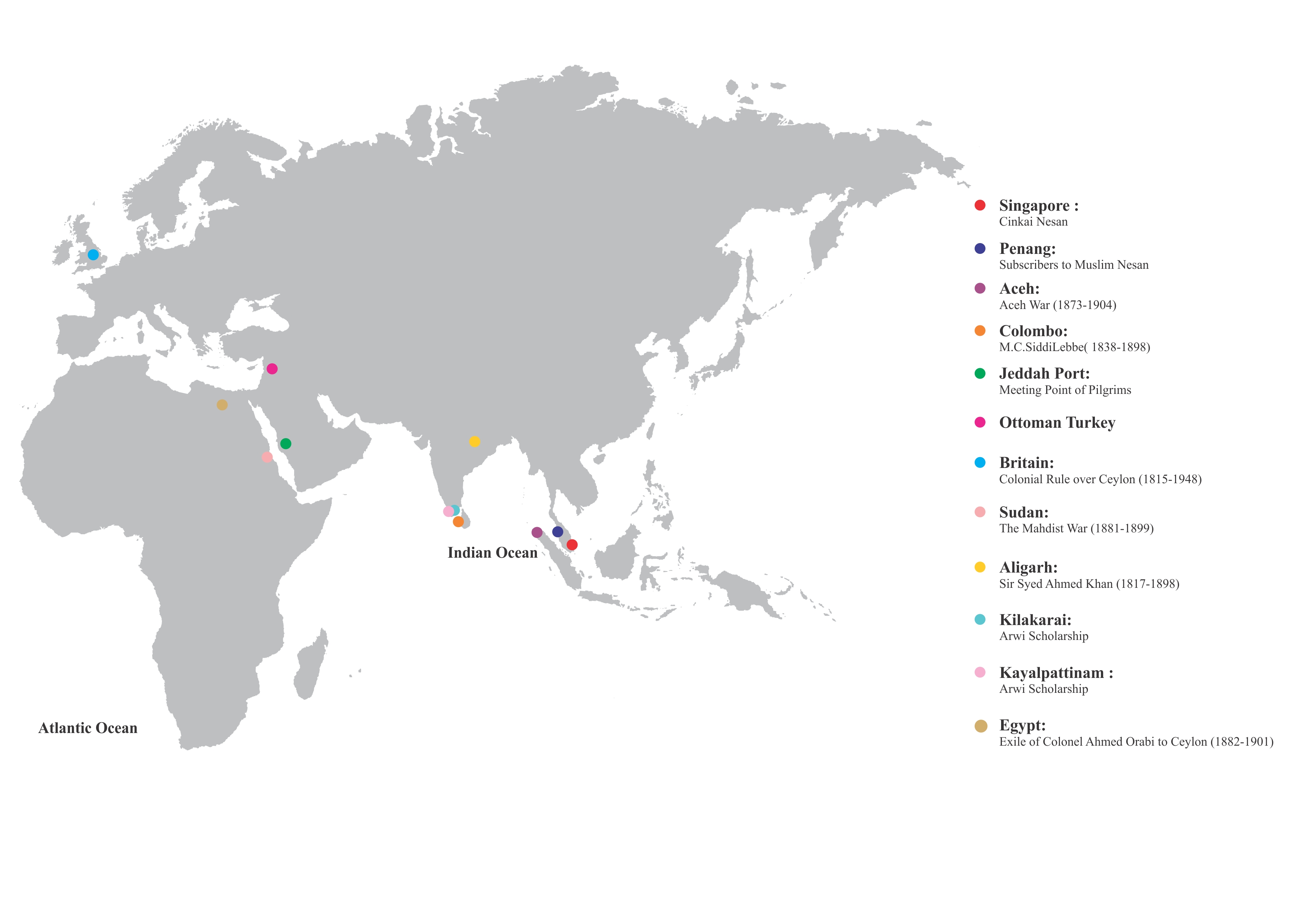Photograph by author, from the National Library and Documentation Services Board, Colombo.
The Muslim community is at the centre of news each day- rarely for the right reasons. The unfolding of the Islamic State has shown the worst ways in which religious identities could be abused. The conflict in Yemen reveals that even the guardians of the religion’s most sacred sites are capable of inhuman violence against co-religionists. It is not simply a case the perpetrators of ungodly acts of violence in the name of religion. The Syrian victims of conflict, the Palestine question, the decades long Kashmiri struggle and Rohingya refugee crisis are among examples within Asia of a people at the centre of global political questions and crimes against humanity. At home in Sri Lanka, the narratives of displacement of Muslims over the civil war and rise and fall of tensions over safety and security in a global context of Islamophobia contribute uncertainties of a peaceful future of coexistence. Each of the examples mentioned above have their own historical, economic and socio-political narrative and counter-narratives. However one underlying factor remains that majority of the peoples embroiled in these conflicts have either been born to, practice or identify with the religion of Islam at different levels.
In celebration and reflection on pioneering journalism through the years, on the 10th anniversary of Groundviews, I have selected to revisit the history of the first Ceylon Moor newspaper dedicated to affairs of the ‘Muslim’ world. The publication titled Muslim Nesan (The Muslim Friend) engaged in journalistic production on affairs of Muslim identity, culture, religion, education and struggle under the yoke of British colonialism from 1882-1889 . As access to information and technologies of reportage advance rapidly, the world faces an increasing need for reflection and responsible responses to matters that matter. Muslim Nesan is an example to take from the past. A lesson of thought and action in tandem as we move toward the new year 2017- into an uncertain near future.
Muslim Nesan was founded and edited by Mohammed Cassim Siddi Lebbe Esqr., the son of the Head Moorman of Kandy. While Siddi Lebbe is known best as one of the founders of Colombo’s Anglo Mohammedan School and Zahira College, my article seeks to understand his career as a pioneering journalist and newspaper editor at the heart of Colombo toward the final decade of the 19th century. Placed awkwardly behind screens of the seminar room of the National Library and Documentation Services Board, Ministry of Education hangs the portrait of this Moorman who was instrumental in altering the course of journalism within the community by establishing a publication of repute among the Tamil speaking worlds of South and Southeast Asia . His portrait sits in a distinguished company of portraits including Dr. R.L.Spittel, Swami Vipulananda and Rev. Sri Sumangala Thero among others, however, I could not help but notice its inconspicuous placement.
Historiography on the topic of Ceylon Moor journalism is relatively limited. Despite this, the legacy of Siddi Lebbe is a useful reflection on the past. Living in a time where the multiple cultures, histories and identities of Muslims is questioned and re-questioned at home and across the world, Lebbe’s struggle toward promoting awareness and prompting action, engaging with a style of education for Muslims in harmony with other influences and encouragement of poetry and the arts within the community for men and women alike is remarkable.
Early journalism among the Moors of Ceylon
By no measure was Lebbe isolated in his pursuit of using the medium of journalism through the printed press as a tool in identity formation. In the late 19th and early 20th century sections of the Buddhist, Hindu, Christian and Muslim communities were actively engaged in the pursuit of a form of cultural revivalism through the written word. In this period, fifteen journals were published by Muslim editors in English, Tamil and Arabic-Tamil (Arwi). Among the political motives behind these publications was the need to counter widespread feelings that the Moor community that depended on trade were hesitant in the adoption of the English language. Therefore, an alternate movement began in the 1880’s to promote educational and social reform while working toward adequate political representation.
Muslim reformists and intellectuals of the late 19th century were inspired by Turkish, Egyptian and Indian revivalist and political movements. The figures of Sir Syed Ahmed Khan of the Anglo-Mohammedan College (later Aligarh School) and Colonel Ahmed Orabi Pasha who was in political exile in Sri Lanka from Cairo between the years 1884-1901 are among the prominent influences on Ceylon Moor intellectual activity.
As the first Moor solicitor, member of the Kandy Municipal Council and scholar in the languages of English, Tamil and Arabic who was a follower of the Qadiriya Sufi order, Lebbe was a visionary who ran counter to the general thinking of his community. He worked amid criticism for his writings among religious leaders and laymen alike. A pioneering achievement of Muslim Nesan was that in the short time the publication lasted, Lebbe drew the attention of an inward looking Moor community of developments and struggle taking place in distant lands.
Malay and Moor Intellectual Exchanges
The National Archives of Sri Lanka holds a collection of Malay language newspapers which preceded Muslim Nesan and influenced Lebbe. Alamat Langkapuri (News from Lanka) written in Gundul language functioned as a fortnightly source of printed news among the Malay readership of the island in 1869. Further, a Tamil language Malay newspaper called Unmai (on which information is limited) also played a role in prompting Lebbe to begin Muslim Nesan for the Moors of Ceylon which grew to include a Tamil readership in South and Southeast Asia.
These publications were not strictly confined by bounds of Moor and Malay ethnicity. They were circulated and read in Gundul, Arabic-Tamil and Tamil with writers actively engaging in reading and translating each other’s works.
Issues Central to Muslim Nesan
The Tamil language newspaper dealt primarily with international affairs within and outside the Muslim world. It was published from a printing press in Colombo Fort . Central to this weekly production were articles related to the freedom movements in Egypt and the Sudan. The wide readership of Muslim Nesan across the seas included audiences in parts of Singapore, Penang and South India. In this time. upto eleven articles regarding the Mahdiyya Movement unfolding in the Sudan originally published in Muslim Nesan were reprinted in Singapore by its Tamil press. Singaporean Tamil newspapers such as Cinkai Nesan in Singapore and Vitya Vicarini in Penang and Nagore carried articles written by journalists from Ceylon on international affairs.
Despite Muslim Nesan being identified as a source for reliable accounts on activities unfolding in far parts of the world, Lebbe was aware and sensitive to the distortions in information received and the inadequacy of ‘accepted’ news. In May 1889 Lebbe stated “We are ignorant of the truth in the affairs of the Sudan”. The newspaper also had a network of anonymous correspondents from Penang and Singapore who provided information and firsthand reports from refugees from the Aceh War over the late 19th century.
In identity politics at home, the Muslim Nesan directly engaged in a series of articles in clear opposition to the views put forward by Sir Ponnambalam Ramanathan on the topic of Ethnology of the Moors of Ceylon in 1888. Sir Ramanathan’s views on the cultural and linguistic affinity to Tamils by several Muslims including Lebbe and I.L.M Abdul Azeez on behalf of the Moors of Ceylon.
Remembering Lebbe
A reflection on the times and writings of Siddi Lebbe over the years of Muslim Nesan is relevant in the study of pioneering journalists , who connected the island to the world. Living in an age of information at our fingertips, understanding the relatively limited avenues to information available in the 1880’s, the extent of reflection on matters of significance to its readership provided by Lebbe demonstrates much we can learn from.
Much like Siddi Lebbe adopted the technologies of the telegraph and printed press to enhance awareness and action from within the community, it may be useful to explore the need for similar avenues in the present. A reputed and reliable publication initiated by the Sri Lankan Moor community may contribute toward ably and effectively communicating positions on issues that matter locally and globally .
While present technologies adopted in journalism and the wars of the world are a world away from Lebbe’s time, I cannot help but imagine how he would have responded to the recent call of an elderly Syrian man as recorded by Al-Jazeera in the Last Messages from Aleppo:
“Oh Muslims, from the East to the West. Where are you?”



